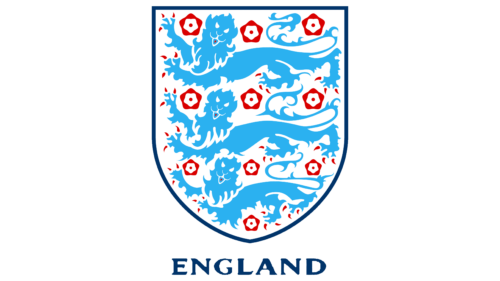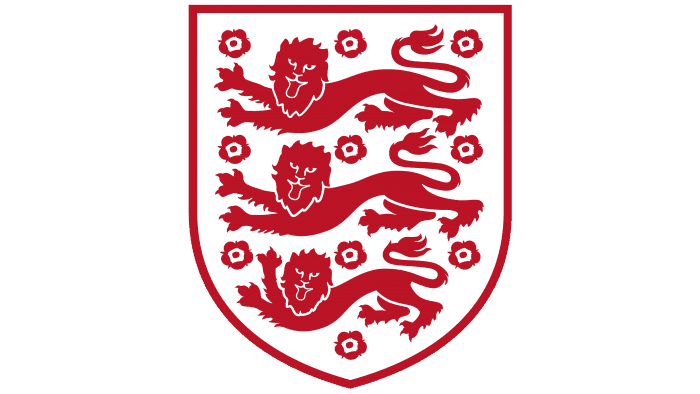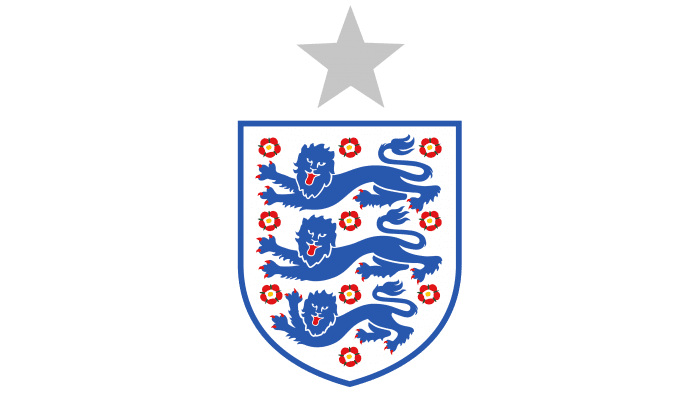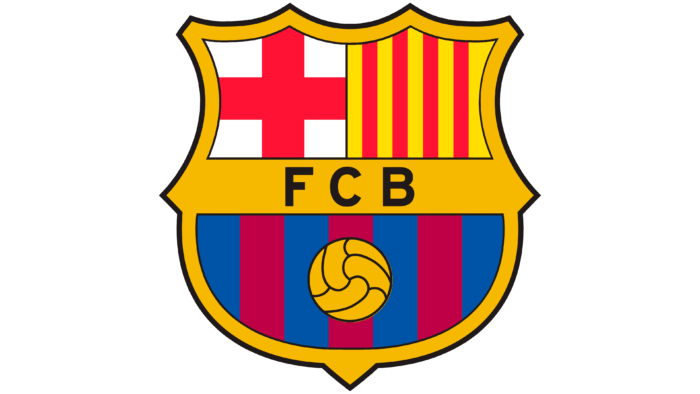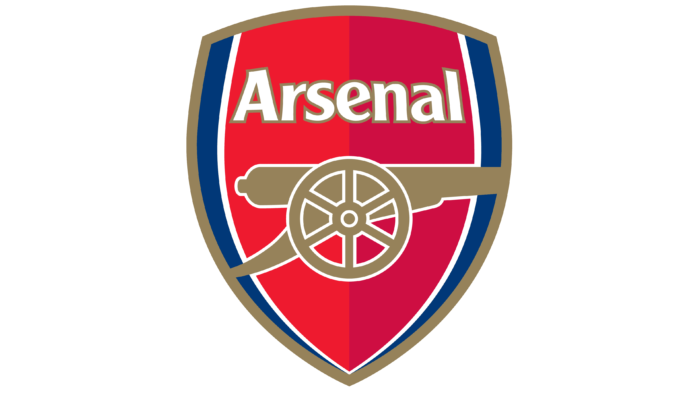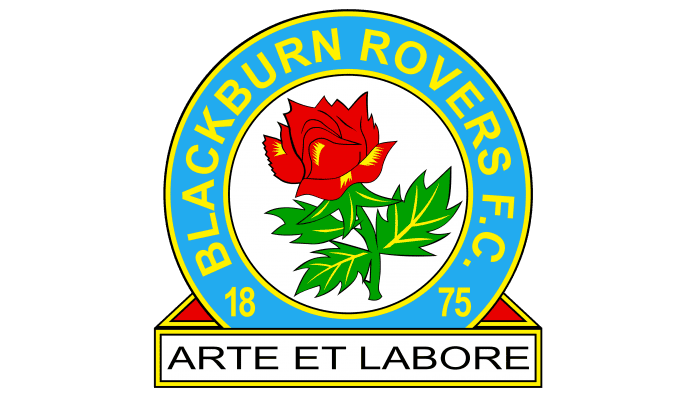The Football Association uses an emblem that signifies its connection to the home country. The England logo contains important national symbols that speak of the incredible patriotism of the sports organization. Even the colors here are chosen deliberately – each of them carries a deep meaning.
England National Football Team: Brand Overview
The England national football team, one of the oldest and most esteemed in the world, carries a storied legacy as the birthplace of modern football. Their journey brims with historic milestones and legendary players.
The saga began in 1872 with a 0-0 draw against Scotland, marking the first-ever international football match. Throughout the early 20th century, England dominated the British Home Championship but initially shied away from World Cup participation. Their World Cup debut came in 1950, marked by an unexpected loss to the United States.
The zenith of English football arrived in 1966 when the team clinched the World Cup on home soil. The final saw England triumph over West Germany with a 4-2 victory in extra time. Geoff Hurst’s historic hat-trick and Bobby Moore’s captaincy remain etched in football lore. This victory stands as England’s sole major international trophy to date.
Post-1966, England experienced a period of turbulence, failing to qualify for the World Cups in 1974 and 1978. The 1990 World Cup offered a glimpse of resurgence, as England reached the semifinals, only to lose to West Germany in a penalty shootout and finish fourth. Euro 1996 also saw them reach the semifinals, where they faced another penalty shootout defeat to Germany.
From 1996 to 2006, England’s lineup featured stars like David Beckham, Steven Gerrard, Frank Lampard, and Michael Owen. Despite the talent, the team often faltered at critical moments, including failing to qualify for Euro 2008 and early exits in the 2010 and 2014 World Cups. Euro 2016 brought a shocking round-of-16 defeat to Iceland.
Gareth Southgate’s appointment as manager in 2016 marked a turning point. Under his leadership, England reached the semifinals of the 2018 World Cup, their best performance since 1990, but lost to Croatia in extra time. Euro 2020, held in 2021, saw England reach the final for the first time, where Italy narrowly defeated them in a penalty shootout at Wembley Stadium.
Today’s England squad brims with young talent, featuring players like Harry Kane, Phil Foden, and Jude Bellingham. The team’s fast-paced and athletic style of play continues to excite fans, making them favorites for future tournaments.
English football legends include Bobby Charlton, Gary Lineker, Alan Shearer, David Beckham, and Wayne Rooney. The English Premier League, one of the world’s most competitive national leagues, plays a crucial role in developing local talent and attracting top players globally. Despite having only one major trophy, England remains a respected force in international football, celebrated for its rich history and foundational role in the sport.
Now, the main symbol on the emblem of the England team is the lion, which replaced the leopard, a symbol of the Plantagenet dynasty that ruled the country from 1154. But back then, the future beast was depicted alone on a red background, symbolizing a blood-drenched battlefield. In 1189, Richard the Lionheart ascended the throne, and during his reign, he added two more predators to the emblem, which the islanders dubbed “the lions on the coming guard.” But why exactly three?
One theory suggests that when Richard returned from the Crusades and reclaimed his usurped throne from his brother, he replaced the old seal with an image of two battling lions with a new one, symbolizing a sign of renewed power. Another theory suggests that Richard needed money after being freed from captivity and paying a ransom, so he introduced a new seal, forcing vassals to pay to defend their rights.
Meaning and History
In 1872, during the first international match against Scotland, the English needed a logo to symbolize national pride. Therefore, they chose the “Three Lions”. Gold and red were replaced by blue and white. The white color laid the foundation for the English flag – Saint George. The three lions are depicted on the Royal Coat of Arms of England, so the Football Association asked for permission from the royal family to use it.
The 10 Tudor roses are the white and red flowers present on the England emblem as a symbol of reconciliation between the Yorks and Lancasters after the War of the Roses in 1485. It’s unclear why there are exactly ten roses. Perhaps it signifies the number of players. But where is the goalkeeper?
The England national football team, which defends the country’s honor in international competitions, has had several versions of the same emblem since the 1950s. All seven versions are the same rectangular heraldic shields with a sharp base. Inside them are depicted three guardian lions and ten Tudor roses.
The heraldic animals are taken from King Richard I’s seal, symbolizing the team’s patriotism. The roses represent the ten divisions of the Football Association – one for each. However, traditional colors did not appear immediately: from 1879 to 1949, the shield with lions was adorned only with a crown, which subsequently disappeared.
Since 2003, the England national football team periodically used an emblem with a five-pointed star located right where the crown used to be. It symbolizes the victory in the 1966 World Cup.
What is England?
England is the national team representing England in international football competitions. It is managed by the Football Association. It is one of the oldest and most successful teams, having won many major tournaments. The team played its first match in 1870.
1879 – 1950
Three identical, schematically drawn lions in crowns, each raising a paw, are depicted one above the other in a vertical position. The lions look exactly alike and have an identical pose. Behind them is a pentagonal coat of arms, the two lower corners of which are rounded. Above it is a large imperial crown, skillfully trimmed with red velvet and blue sides. The repetition of lions and the use of a crown gives the image a regal and authoritative character, while the geometric shapes create a sense of stability and structure.
1950 – 1993
There was a time when lions were depicted surrounded by roses, with three flowers depicted above each animal. These elements harmoniously combined when roses separated the lions, outlining the boundaries of their individual space. This time, all three animal kingdom representatives are depicted in the ornate baroque style, abounding in round details, swirls, and spikes.
The manes and faces of the lions resemble artificial masks, and their poses are relaxed: the front paws are stretched out, and the back ones are drawn back. Such an arrangement suggests that the kings of the beasts have comfortably stretched out, content with their possessions.
The color palette of the emblem predominates dark blue and red, creating a rich and bold visual effect. The background for this design serves as a triangular shield, adding a sense of tradition and formality to the overall composition. The union of lions with roses embodies elegance, while the pronounced baroque elements lend sophistication. The emblem resonates with power and grace, balancing between authority and calm.
1993 – 1998
In the refined design, special attention was given to the sizes of the flowers: the roses gradually decreased in size from top to bottom. The upper roses are depicted prominently, while the lower ones are significantly smaller. Such a change in scale lends depth to the visual representation and creates an appealing effect, drawing the gaze.
The images of heraldic lions express a sense of superiority. The beasts demonstrate their dominance and power to those they encounter. To emphasize their importance, the animals’ tongues and claws are painted red, creating a bright contrast against the blue background. These details lend to the composition’s liveliness and vividly highlight the animals’ features.
Under the shield, which now has a rounded bottom end, is the word “England.” All letters are uppercase, and the font is adorned with tiny serifs. The textual element lends a formal and dignified aspect to the overall design, linking the emblem to its national identity.
The combination of visual elements in this design – the gradient size of roses, color contrast, the assertive pose of the lions, and the inclusion of the country’s name – all contribute to creating a symbol that embodies pride, elegance, and a sense of historical continuity.
1999 – 2003
In the updated design, artists made several noticeable changes to achieve a more cohesive and vivid visual perception. They brought all parts of the lions closer to their torsos, which were previously positioned at a certain distance from each other (e.g., one of the paws and the head). This adjustment gives the lions a more unified and powerful look.
The claws and tongues were enlarged, adding boldness to the animals’ expressions. Additional attention to detail was paid by adding spikes to the roses, enhancing their realism and texture. These changes enhance the impression of regality and authority of the emblem.
The knightly shield was narrowed, giving the overall design a more modern and sleek look. Perhaps the most significant change was the dark blue rectangle above the coat of arms. It is now adorned with the white word “England,” set in a font that mimics a simplified Old English style and is a clear nod to the country’s heritage.
The new placement of the country’s name above the heraldic elements lends the design a particular significance and pride. The dark blue background creates a dignified contrast, highlighting the inscription, and the stylistic choice of font links the logo to traditions and history.
These design changes resulted in a more sophisticated and cohesive emblem, combining historical and contemporary aspects of symbolism and embodying a sense of national identity and strength.
2003 – 2009
The logo transformed, reflecting a more modern approach to design and moving somewhat away from the baroque style. The abundant swirls and spikes disappeared, and the bodies of the lions ceased to be as elongated as before. The animals themselves look less menacing, permeated with a sense of calm elegance.
The lions now have shorter manes and soft facial features, lending their appearance a gentleness. Interestingly, the third lion differs from the first two: it is smaller and raises one front paw. This subtle variation is a response to the specific design of the knightly shield, which narrows towards the bottom.
The flowers on the emblem have been changed: classic red petals, a yellow center, and green accents. Such a color scheme lends the emblem freshness and naturalness, contrasting with the more stylized depiction of the lions.
The inscription above the shield is done in a smooth sans-serif font, a departure from the previous Old English style. Such a choice gives the logo a more modern and accessible look, enhancing readability while still maintaining a dignified appearance.
The revised logo represents a balanced combination of tradition and modernity. While retaining key elements of historical symbolism, the new design introduces a more subtle and streamlined aesthetic. As a result, the logo resonated with a broad audience, paying homage to the cultural heritage it represents and creating a harmonious chord between the past and present.
2009 – 2012
The football organization decided to simplify the logo, removing the inscription above the shield. Designers implemented this change without altering other design elements. However, a subtle adjustment was made to the color palette: the dark blue shade that previously dominated the emblem was lightened.
This seemingly minor change noticeably affected the overall appearance of the logo. By lightening the blue color, designers gave the emblem a fresher and more accessible look. The absence of the inscription gives the emblem a cleaner and more focused look, allowing the other elements to stand out more prominently.
2012 – 2013
Maintaining the same style and outlines of the lions and roses, the creators of the new logo decided to make everything in bold red.
This change is not a change in hue; this represents a significant shift in the logo’s visual appeal. The red color lends the emblem of passion, energy, and strength, closely aligning with the values typically associated with sports and competition.
The red uniform creates a cohesive and striking image, making the logo recognizable and distinctive. It allows for a new emphasis on the details of the lions and roses, highlighting their shape and design without the distraction of numerous colors.
2013 – today
The England national football team returned to its 2009 logo – a symbol that meets modern requirements while retaining traditional heraldic images. In this version, the three lions are depicted without excessive decorations, bends, and elongated spikes often found in old styles.
Each lion looks strong and noble yet streamlined and updated, reflecting a contemporary aesthetic that matches the progressive identity of the team. The focus on simplifying the form highlights the primary characteristics of the lions, conveying an image of strength, unity, and pride.
The flowers are carefully crafted between the lions, with yellow centers and bright red petals. The green sepals peeking through them lend the design realism and sophistication. Such a combination of colors introduces a harmonious and vibrant contrast to the overall appearance.
The predominant color of the logo is blue, which adds depth and evokes a sense of determination and excellence. This shade is linked to the team’s and country’s history and embodies calm confidence.
By returning to the 2009 design, the England national football team chose a logo that symbolizes its idea and mission. Combining a modern style with elements of tradition forms a visual identity rooted in history and looking toward the future. This visual statement unites the past and present, embodying the team’s commitment to excellence, heritage, and innovation.
England National Football Team: Interesting Facts
The England soccer team is one of the oldest in the world and has a lot of cool stories.
- First Game: In 1872, England played the first international soccer game against Scotland. It was a tie, with no goals scored.
- World Cup Win: England won its only World Cup in 1966 when they played in London. They beat West Germany 4-2, and Geoff Hurst scored thrice in that game.
- Wembley Stadium: They play most of their games in London, which people call “The Home of Football.” It’s a famous place for soccer.
- Three Lions Badge: Their symbol is three lions, which goes back to the 12th century and was used by Richard the Lionheart as a sign of the English throne.
- Trophy Found by a Dog: Right before the 1966 World Cup, the trophy was stolen but then found by a dog named Pickles under a hedge.
- Big Rivalries: England’s biggest soccer rivalries are with Scotland, Germany, and Argentina. Games against these teams are always exciting.
- First Black Player: Viv Anderson was the first black player to play for England in 1978.
- Penalty Struggles: England has often lost in penalty shootouts during big tournaments, which has been tough for their fans.
- Most Games Played: Peter Shilton played for England 125 times, more than anyone else.
- Top Scorer: Wayne Rooney scored 53 goals for England, making him the top scorer.
England’s soccer team is part of soccer history. It has great players, big games, and many fans cheering for it. It is known as the “Three Lions.” The England National Football Team, governed by the Football Association (FA), has a rich history and significant presence in international football. Competing under UEFA and FIFA, England’s notable achievements include winning the FIFA World Cup in 1966. The team regularly participates in the FIFA World Cup and the UEFA European Championship, reaching the semi-finals in 1968, 1996, and 2020.
Font and Colors
From 1993 to 2009, the word “England” was added to the shield. Initially, it was done in a serif font, but in 2003, designers changed the letter design, opting for a simple sans-serif font. Modern logos do not have inscriptions.
The team’s graphic symbols are remarkably similar, except for a small difference in details and palette. The lions have always been blue or dark blue, except from 2012-2013. The contour of the shield usually matched the color of the heraldic animals. The flowers have traditionally been red – designers decided not to change the original appearance of the Tudor roses.




